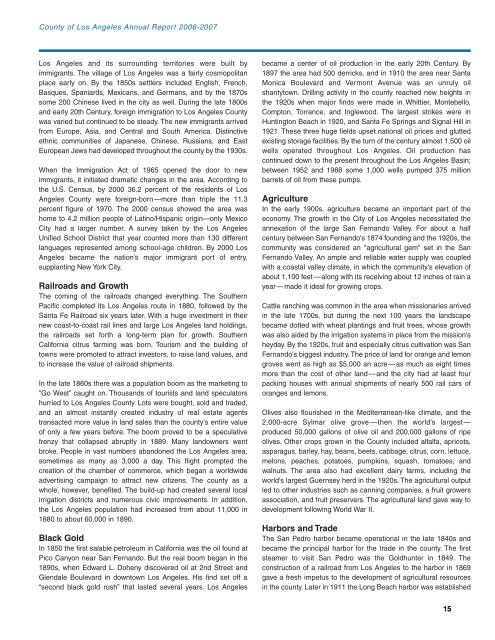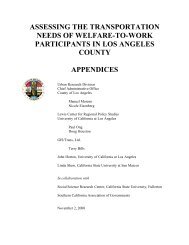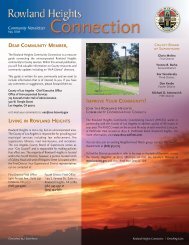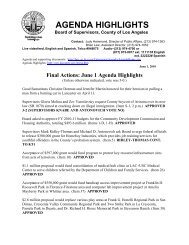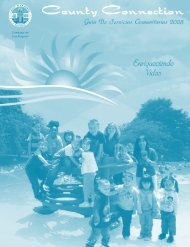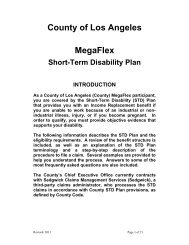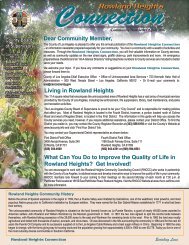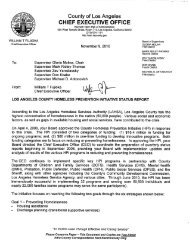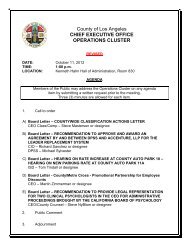Annual Report - Chief Executive Office - Los Angeles County
Annual Report - Chief Executive Office - Los Angeles County
Annual Report - Chief Executive Office - Los Angeles County
Create successful ePaper yourself
Turn your PDF publications into a flip-book with our unique Google optimized e-Paper software.
<strong>County</strong> of <strong>Los</strong> <strong>Angeles</strong> <strong>Annual</strong> <strong>Report</strong> 2006-2007<br />
<strong>Los</strong> <strong>Angeles</strong> and its surrounding territories were built by<br />
immigrants. The village of <strong>Los</strong> <strong>Angeles</strong> was a fairly cosmopolitan<br />
place early on. By the 1850s settlers included English, French,<br />
Basques, Spaniards, Mexicans, and Germans, and by the 1870s<br />
some 200 Chinese lived in the city as well. During the late 1800s<br />
and early 20th Century, foreign immigration to <strong>Los</strong> <strong>Angeles</strong> <strong>County</strong><br />
was varied but continued to be steady. The new immigrants arrived<br />
from Europe, Asia, and Central and South America. Distinctive<br />
ethnic communities of Japanese, Chinese, Russians, and East<br />
European Jews had developed throughout the county by the 1930s.<br />
When the Immigration Act of 1965 opened the door to new<br />
immigrants, it initiated dramatic changes in the area. According to<br />
the U.S. Census, by 2000 36.2 percent of the residents of <strong>Los</strong><br />
<strong>Angeles</strong> <strong>County</strong> were foreign-born—more than triple the 11.3<br />
percent figure of 1970. The 2000 census showed the area was<br />
home to 4.2 million people of Latino/Hispanic origin—only Mexico<br />
City had a larger number. A survey taken by the <strong>Los</strong> <strong>Angeles</strong><br />
Unified School District that year counted more than 130 different<br />
languages represented among school-age children. By 2000 <strong>Los</strong><br />
<strong>Angeles</strong> became the nation’s major immigrant port of entry,<br />
supplanting New York City.<br />
Railroads and Growth<br />
The coming of the railroads changed everything. The Southern<br />
Pacific completed its <strong>Los</strong> <strong>Angeles</strong> route in 1880, followed by the<br />
Santa Fe Railroad six years later. With a huge investment in their<br />
new coast-to-coast rail lines and large <strong>Los</strong> <strong>Angeles</strong> land holdings,<br />
the railroads set forth a long-term plan for growth. Southern<br />
California citrus farming was born. Tourism and the building of<br />
towns were promoted to attract investors, to raise land values, and<br />
to increase the value of railroad shipments.<br />
In the late 1860s there was a population boom as the marketing to<br />
“Go West” caught on. Thousands of tourists and land speculators<br />
hurried to <strong>Los</strong> <strong>Angeles</strong> <strong>County</strong>. Lots were bought, sold and traded,<br />
and an almost instantly created industry of real estate agents<br />
transacted more value in land sales than the county's entire value<br />
of only a few years before. The boom proved to be a speculative<br />
frenzy that collapsed abruptly in 1889. Many landowners went<br />
broke. People in vast numbers abandoned the <strong>Los</strong> <strong>Angeles</strong> area,<br />
sometimes as many as 3,000 a day. This flight prompted the<br />
creation of the chamber of commerce, which began a worldwide<br />
advertising campaign to attract new citizens. The county as a<br />
whole, however, benefited. The build-up had created several local<br />
irrigation districts and numerous civic improvements. In addition,<br />
the <strong>Los</strong> <strong>Angeles</strong> population had increased from about 11,000 in<br />
1880 to about 60,000 in 1890.<br />
Black Gold<br />
In 1850 the first salable petroleum in California was the oil found at<br />
Pico Canyon near San Fernando. But the real boom began in the<br />
1890s, when Edward L. Doheny discovered oil at 2nd Street and<br />
Glendale Boulevard in downtown <strong>Los</strong> <strong>Angeles</strong>. His find set off a<br />
“second black gold rush” that lasted several years. <strong>Los</strong> <strong>Angeles</strong><br />
became a center of oil production in the early 20th Century. By<br />
1897 the area had 500 derricks, and in 1910 the area near Santa<br />
Monica Boulevard and Vermont Avenue was an unruly oil<br />
shantytown. Drilling activity in the county reached new heights in<br />
the 1920s when major finds were made in Whittier, Montebello,<br />
Compton, Torrance, and Inglewood. The largest strikes were in<br />
Huntington Beach in 1920, and Santa Fe Springs and Signal Hill in<br />
1921. These three huge fields upset national oil prices and glutted<br />
existing storage facilities. By the turn of the century almost 1,500 oil<br />
wells operated throughout <strong>Los</strong> <strong>Angeles</strong>. Oil production has<br />
continued down to the present throughout the <strong>Los</strong> <strong>Angeles</strong> Basin;<br />
between 1952 and 1988 some 1,000 wells pumped 375 million<br />
barrels of oil from these pumps.<br />
Agriculture<br />
In the early 1900s, agriculture became an important part of the<br />
economy. The growth in the City of <strong>Los</strong> <strong>Angeles</strong> necessitated the<br />
annexation of the large San Fernando Valley. For about a half<br />
century between San Fernando's 1874 founding and the 1920s, the<br />
community was considered an "agricultural gem" set in the San<br />
Fernando Valley. An ample and reliable water supply was coupled<br />
with a coastal valley climate, in which the community's elevation of<br />
about 1,100 feet—along with its receiving about 12 inches of rain a<br />
year—made it ideal for growing crops.<br />
Cattle ranching was common in the area when missionaries arrived<br />
in the late 1700s, but during the next 100 years the landscape<br />
became dotted with wheat plantings and fruit trees, whose growth<br />
was also aided by the irrigation systems in place from the mission's<br />
heyday. By the 1920s, fruit and especially citrus cultivation was San<br />
Fernando's biggest industry. The price of land for orange and lemon<br />
groves went as high as $5,000 an acre—as much as eight times<br />
more than the cost of other land—and the city had at least four<br />
packing houses with annual shipments of nearly 500 rail cars of<br />
oranges and lemons.<br />
Olives also flourished in the Mediterranean-like climate, and the<br />
2,000-acre Sylmar olive grove—then the world’s largest—<br />
produced 50,000 gallons of olive oil and 200,000 gallons of ripe<br />
olives. Other crops grown in the <strong>County</strong> included alfalfa, apricots,<br />
asparagus, barley, hay, beans, beets, cabbage, citrus, corn, lettuce,<br />
melons, peaches, potatoes, pumpkins, squash, tomatoes, and<br />
walnuts. The area also had excellent dairy farms, including the<br />
world's largest Guernsey herd in the 1920s. The agricultural output<br />
led to other industries such as canning companies, a fruit growers<br />
association, and fruit preservers. The agricultural land gave way to<br />
development following World War II.<br />
Harbors and Trade<br />
The San Pedro harbor became operational in the late 1840s and<br />
became the principal harbor for the trade in the county. The first<br />
steamer to visit San Pedro was the Goldhunter in 1849. The<br />
construction of a railroad from <strong>Los</strong> <strong>Angeles</strong> to the harbor in 1869<br />
gave a fresh impetus to the development of agricultural resources<br />
in the county. Later in 1911 the Long Beach harbor was established<br />
15


